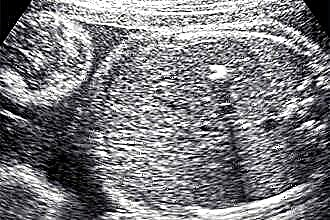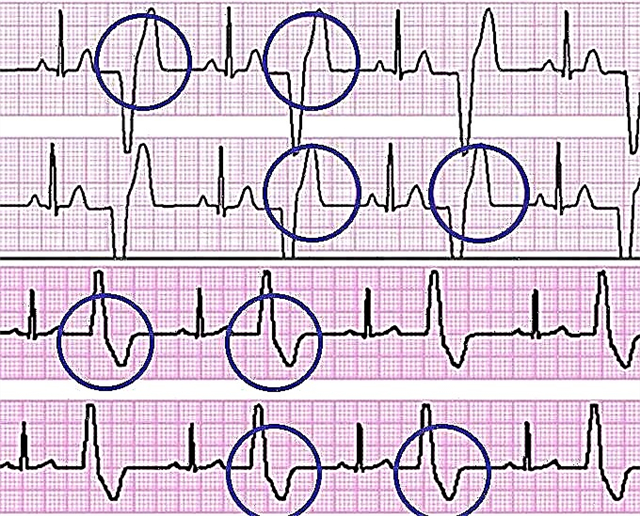Throughout the pregnancy, the obstetrician-gynecologist monitors the expectant mother and baby. One of the most accessible, safe and at the same time informative methods for assessing a child's condition is auscultation. By the frequency of the fetal heartbeat, which is listened to through the anterior abdominal wall, the parameters of its vital activity are judged. Consider the existing methods and the main indicators of the work of the heart of the crumbs.
Measuring technique, apparatus and instruments
 The heart of the embryo is formed on the 17-20th day of intrauterine development from two mesenchymal anlages, which then turn into a tube. In the fourth week, the atrial septum appears. By the eighth-ninth - the fetal heart anatomically already with four chambers.
The heart of the embryo is formed on the 17-20th day of intrauterine development from two mesenchymal anlages, which then turn into a tube. In the fourth week, the atrial septum appears. By the eighth-ninth - the fetal heart anatomically already with four chambers.
Depending on the gestational age, the fetal heartbeat is listened to by the following methods:
- auscultation with a stethoscope, phonendoscope;
- ultrasonography;
- cardiotocography;
- echocardiography.
The first heartbeats are counted already in the sixth week of pregnancy using an ultrasound machine. Initially, they are about 110-130 beats per minute, but by the end of the first trimester they increase to 170-190. From 12 weeks until the very birth, the fetal heart rate is normally 120-160.
Echocardiography - optional research, prescribes an obstetrician-gynecologist for certain indications. With the help of this modern and accurate method, blood circulation in the heart and blood vessels is studied. The optimal duration is from 19 to 28 weeks of pregnancy.
Cardiotocography - a common method for assessing the condition of the fetus. Today, CTG is the leading study of the nature of the cardiac activity of a future baby. Based on the analysis of changes in the child's heart rate at rest and during active movements. Diagnosed in the third trimester of pregnancy.
Auscultation of fetal heart sounds - with the help of an obstetric stethoscope, which is applied to the belly of the pregnant woman with the wide part to the left or right, above or below the navel, depending on the position, type and position of the fetus. Heart sounds are heard from 20 weeks.
Home control
There are situations where the fetal heart rate is monitored every day at home. After all, mother is worried about the baby's condition, it is important for her to know that his heart is beating and developing.
They listen to the fetal heartbeat at home in several ways. The easiest is to put your ear to your stomach. The heartbeat of a child with this method of diagnosis is heard only after 30 weeks of pregnancy. This method is ineffective because it depends on the woman's fatty tissue, the thickness of which distorts the conduction of the sound of the beating heart.
More reliable is the calculation of the fetal heart rate using an obstetric stethoscope, which is applied to the belly of the pregnant woman's wide part. However, this requires daily training and a patient assistant. In addition to knowledge about the points of auscultation, it is necessary to distinguish between extraneous noises (the pulse of the future woman in labor, intestinal motility). Correctly attaching the diaphragm of the device to the anterior abdominal wall of a woman, a typical fetal heartbeat sound is heard using a phonendoscope.
Today, the expectant mother assesses the work of the baby's heart, without leaving the house, with a minimum error. For this purpose, they purchase a device for listening to the fetal heartbeat at home - a fetal doppler. The work is based on the use of ultrasound, the level of which is eight times lower than when performing ultrasound. Therefore, its use is considered safe for the child. They sell such a device for listening to the heartbeat in a pharmacy or in a medical equipment store.
The advantages of such a device:
- convenience and ease of use;
- the ability to independently assess the fetal heart rate in a quick time;
- use from 12 weeks.
Among the disadvantages are:
- limited time of use;
- high price.
What to do in case of deviations from the norm
When using the device to listen to the fetal heartbeat at home, it is necessary to correctly interpret the results obtained in order to react in time and take action if problems arise.

The characteristics of the fetal heart rate include frequency, rhythm, filling and tension. Tachycardia is considered to be an increase in heart rate over 170 beats per minute, bradycardia - a decrease in heart rate below 110. Normal baby's heart sounds are clear and rhythmic.
Changes in these indicators arise for many reasons: from the corny stuffy room in which the pregnant woman is located, to intrauterine fetal hypoxia. Therefore, when deviations in the child's pulse appear, they must seek help from a doctor for a scheduled consultation. Only he will find out the reason for this condition and help keep the baby healthy. For this, the future woman in labor undergoes additional studies (Holter and ECHO-KG (daily ECG monitoring)).
Conclusions
Mothers know that a normal baby's heartbeat is the main indicator of a safe pregnancy. Monitoring the fetal heart should be constant and high-quality in order to avoid erroneous conclusions and further stress. Therefore, for nine months they pay maximum attention to such parameters, and for any deviations they turn to the doctor.



